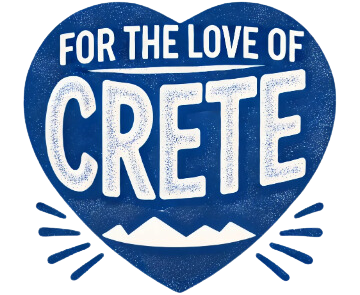The Ancient Palace of Knossos in Crete stands as one of the most significant archaeological sites in Europe. This sprawling complex on the island of Crete, Greece, reveals the secrets of the Minoan civilization through its advanced engineering, intricate architecture, and rich cultural heritage. Before you explore this archaeological wonder, understanding its complete history and significance will transform your visit from a simple tourist stop into a profound journey through ancient Cretan civilization.
Historical Background
Knossos Palace tells a rich historical story spanning over 9,000 years. From its origins as a Neolithic settlement to its peak as the heart of Minoan civilization, this archaeological site showcases the evolution of one of Europe’s earliest advanced societies.
Origins and Early Settlement
The foundations of Knossos date back to 7000 BC, when the first settlers established a modest community of 25-50 residents. These early inhabitants constructed simple huts and began the first agricultural practices in the area.

A significant transformation occurred during the Middle Neolithic period (5000-4000 BC), when the settlement experienced remarkable growth. The population expanded dramatically, reaching 500-1000 inhabitants across generations. This period brought notable architectural advancements, with residents developing more sophisticated building techniques and introducing enhanced structural elements to their homes.
By 3000 BC, Knossos entered a pivotal phase with the dawn of the Early Minoan period. This Bronze Age transition marked a technological revolution for the settlement. The inhabitants mastered bronze crafting and developed advanced pottery techniques, setting the stage for the remarkable civilization that would follow.
The most dramatic transformation came around 1900 BC with the construction of the first palace. This monumental undertaking established Knossos as the ceremonial and political heart of Minoan civilization, forever changing the landscape of ancient Crete.

The Palace’s Golden Age
Between the 19th and 14th centuries BC, Knossos reached its peak of power and sophistication. The main palace complex covered an impressive 22,000 square meters (almost 5.5 acres), making it the largest Minoan palace complex on Crete.
During this period, the palace showcased remarkable architectural and technological achievements:
- Multi-story buildings with elaborate architectural details and grand staircases
- 16 sophisticated storage rooms housing massive pithoi (storage jars) for grain, oil, and other goods
- Advanced hydraulic systems featuring indoor plumbing, drainage networks, and elaborate bathrooms
- A theater area accommodating 400 spectators for public gatherings and ceremonies
- Central courtyards for religious and social activities
- Multiple workshops for craftsmen and artisans

The palace functioned as both a religious sanctuary and an administrative center, demonstrating the complex social and political organization of Minoan society. This dual purpose reflected the sophisticated integration of spiritual and governmental functions within Minoan culture.
Decline and Later Periods
The decline of Knossos unfolded through several distinct historical phases:
- Around 1450 BC: Knossos became the last surviving Minoan palace on Crete after all other palaces were destroyed. During this period, the palace came under strong Mycenaean influence, with Greek replacing the local language in administrative records.
- 1350 BC: A devastating fire ravaged the palace, causing the collapse of the upper stories. This destruction, whether from natural causes or human action, marked the end of the palace’s role as a major power center.
- Post-destruction period: While the palace never regained its former glory, certain areas remained in use for ceremonial purposes. The surrounding town experienced a notable revival around 1200 BC.
- 36 BC: The area became part of a Roman colony named Colonia Iulia Nobilis, beginning a new chapter in its history.
- Later centuries: Knossos maintained a continuous but diminished occupation through various historical periods. The settlement persisted until around 650 CE, when it was finally abandoned as neighboring Heraklion grew in prominence.
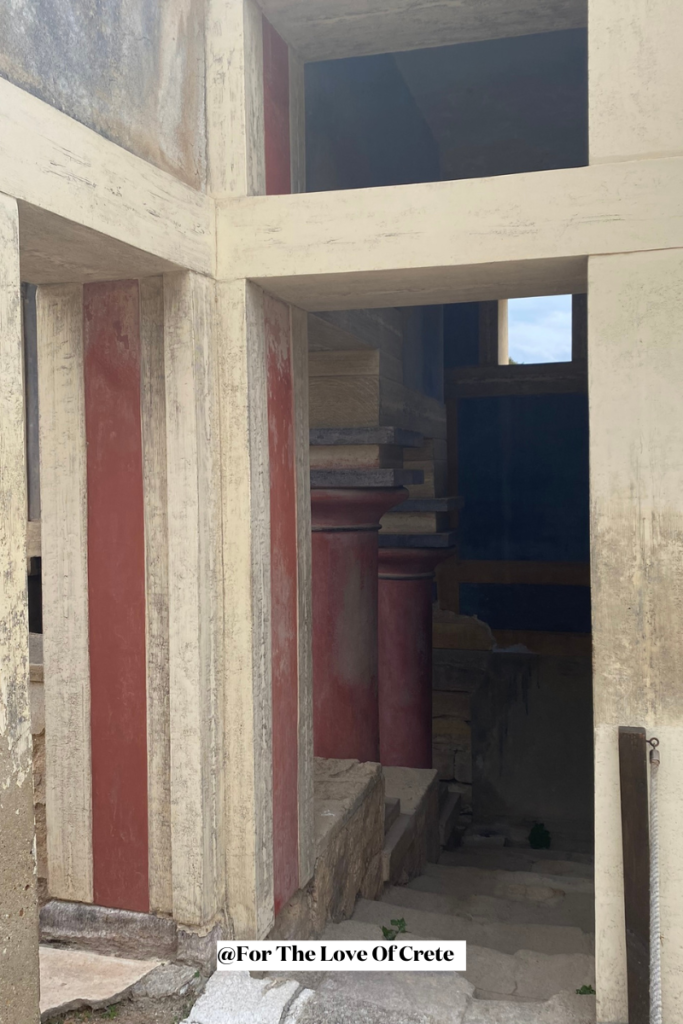
This pattern of decline and adaptation demonstrates Knossos’s remarkable resilience across multiple civilizations and historical periods.
The Minoan Palace Complex
The sprawling Minoan Palace Complex stands as a testament to ancient architectural innovation. This remarkable achievement of ancient engineering spans 22,000 square meters, demonstrating the sophisticated urban planning and architectural capabilities of Minoan civilization.

Palace Architecture
The complex showcases masterful architectural design centered around a vast rectangular central courtyard. This courtyard served as the heart of palace life, hosting everything from important ceremonies to daily administrative activities. The palace rises dramatically in multiple stories, with some sections reaching an impressive flour floors high – a remarkable architectural achievement for the Bronze Age.

The Minoans incorporated advanced engineering solutions throughout the complex, including:
- 150-meter drainage networks
- Sophisticated light wells and ventilation shafts
- Earthquake-resistant wooden beam reinforcements
The builders demonstrated remarkable skill in their use of materials, combining unbaked brick for upper walls with limestone blocks for foundations. Decorative elements featured gypsum slabs and intricate stonework, while clay tiles protected the structures from Cretan weather. Perhaps most impressive was their innovative drainage system, which separated rainwater from waste water – a technology far ahead of its time.
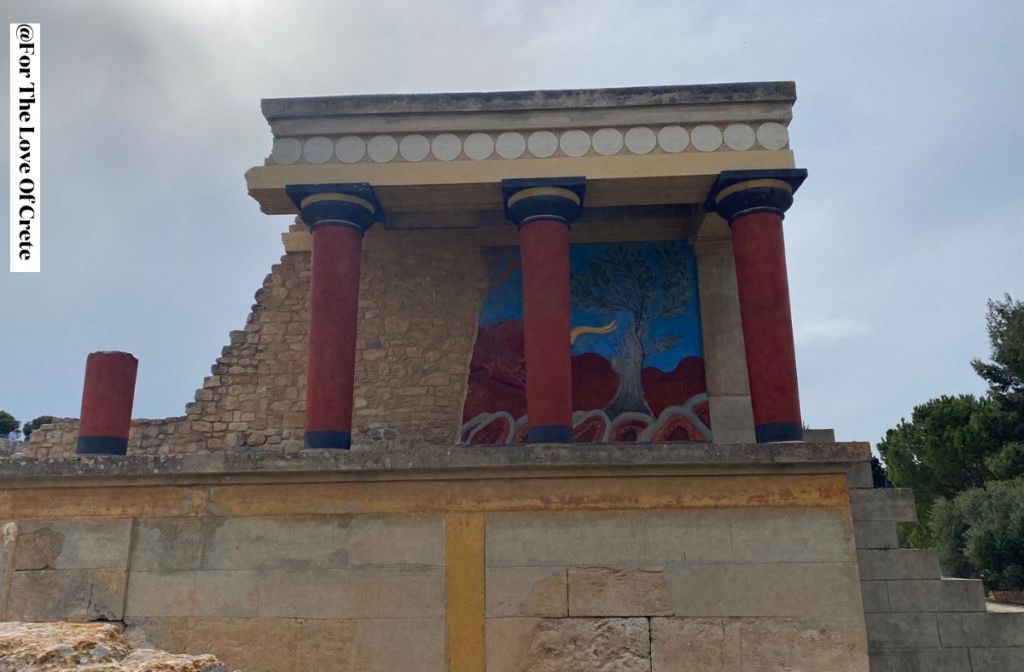
Key Areas to Explore
The Throne Room stands as Europe’s oldest known throne room, featuring the original alabaster throne flanked by vivid griffin frescoes. This ceremonial space, with its gypsum benches along the walls, offers visitors a glimpse into the formal ceremonies of Minoan rulers.
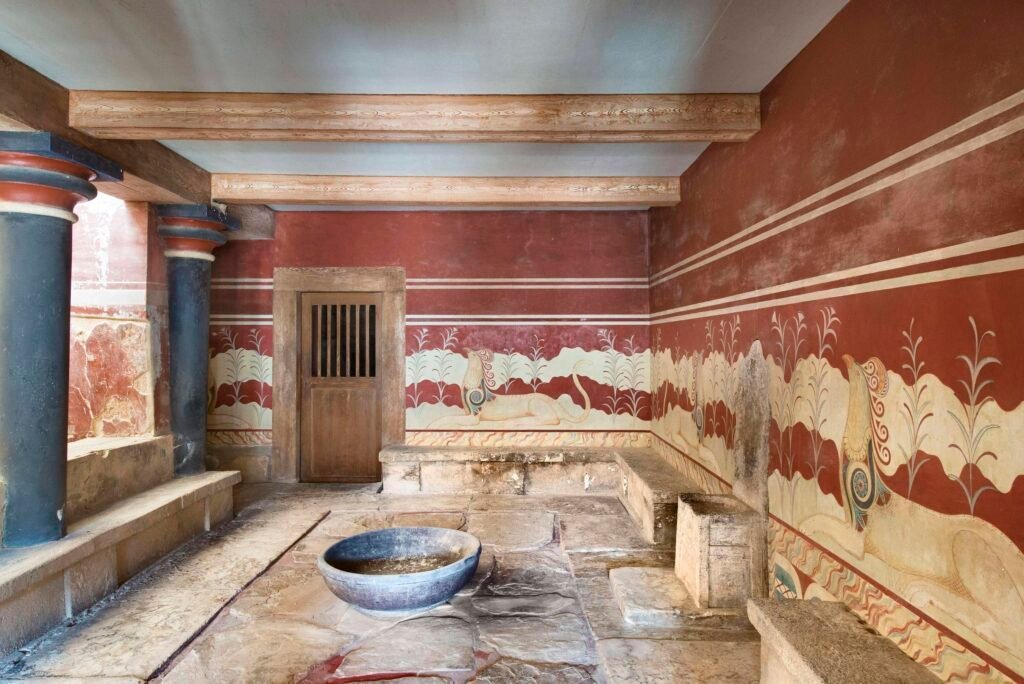
The palace’s West Magazines comprise sixteen long, narrow storerooms that once housed the wealth of Knossos. These sophisticated storage areas contained massive pithoi (storage jars) and demonstrate the complex economic organization of Minoan society.
One of the most significant architectural achievements appears in the Hall of Double Axes, named for the sacred symbols carved into its walls. This area showcases the innovative polythyron system – a series of pier-and-door partitions that could be opened to create large spaces or closed for privacy and climate control.
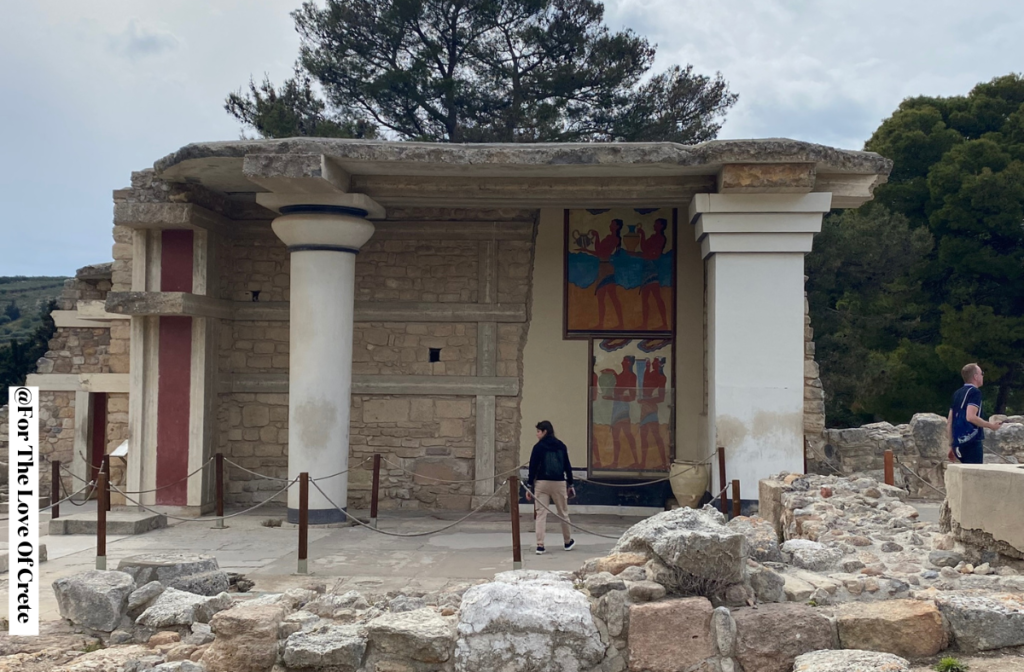
The Residential Quarter, historically called the Royal Apartments by Arthur Evans, represents the height of Minoan architectural sophistication. These living spaces showcased advanced plumbing systems and sophisticated ventilation networks. The quarters feature some of the palace’s most elaborate wall decorations, with vibrant frescoes adorning many rooms. While the exact nature of who occupied these spaces remains a matter of scholarly debate, the exceptional craftsmanship evident throughout this area reflects the refined lifestyle of Minoan elite society.

Life in Ancient Knossos
Archaeological evidence provides fascinating insights into daily life within this complex Minoan settlement. The palace served multiple functions, from administrative center to craft production hub, revealing a sophisticated urban society.
Daily Palace Activities
The archaeological record shows that Knossos functioned as a bustling administrative center. Clay tablets discovered throughout the complex document detailed records of goods, trading activities, and religious offerings. These records appear in two distinct scripts: the earlier Linear A used during the Minoan period, and later Linear B tablets dating to the Mycenaean administration of the palace. The shift in writing systems reflects the significant cultural and administrative changes that occurred at Knossos over time.

The palace complex housed numerous specialized workshops, where skilled artisans created pottery, metalwork, and stone vessels. Storage areas throughout the complex held hundreds of pithoi (large storage jars), suggesting sophisticated systems for managing and distributing resources. These vessels could hold massive quantities of olive oil, wine, and grain – key commodities in Minoan economy.

Religious activities played a central role in palace life, as evidenced by the numerous ritual objects and dedicated spaces found throughout the complex. Discovered artifacts include offering tables, ritual vessels, and detailed documentation of religious ceremonies on clay tablets.
Artistic Heritage
The walls of Knossos showcase some of the finest examples of Minoan artistic achievement. The surviving frescoes, both in original fragments and careful reconstructions, provide valuable insights into Minoan culture and society.

Among the most significant frescoes are:
- The dramatic Bull-Leaping Fresco, one of the palace’s most famous artworks, depicting figures engaging with bulls in what appears to be a ritual or sporting event
- The reconstructed Ladies in Blue fresco, which offers insights into Minoan clothing and adornment
- The vibrant Dolphin Fresco located in the so-called Queen’s Megaron (a name assigned by archaeologist Arthur Evans), demonstrating the Minoan artists’ skill in portraying marine life
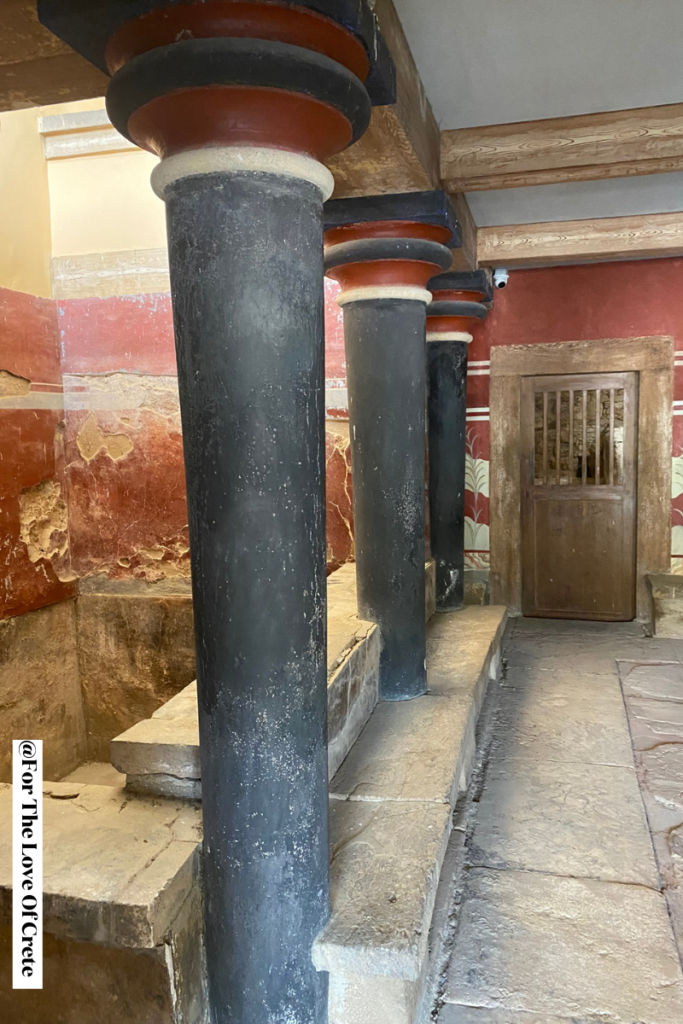
Beyond frescoes, the palace yielded remarkable examples of craftsmanship in various materials:
- Intricately carved stone vessels
- Finely crafted jewelry
- Detailed seal stones showing complex iconography
- Sophisticated ceramic works
The artistic techniques used at Knossos were remarkably advanced for their time. Artisans employed multiple colors, sophisticated composition methods, and innovative painting techniques. Their work provides crucial evidence about Minoan daily life, fashion, religious practices, and social structure.

Visiting Knossos Palace Today
Planning your visit to Knossos requires attention to several key details to ensure the best experience. The site welcomes visitors throughout the year with seasonal operating hours:
- Summer (June-August): 8:00 AM – 7:00 PM
- September: 8:00 AM – 6:00 PM
- October: 8:00 AM – 5:00 PM
- Winter Season: 8:00 AM – 4:00 PM
Important Notes:
- Last admission is 15 minutes before closing time
- The site is closed on major holidays including New Year’s Day, March 25, May 1, Easter Monday, and December 25-26
- Free admission days are offered on March 6, April 18, May 18, the last weekend of September, October 28, and all Sundays from November through March

Essential Visitor Information
Entrance fees include options for:
- Standard adult admission: €16
- Combined ticket with the Heraklion Archaeological Museum (highly recommended)
- Free entry for EU citizens under 25 with valid ID
- Special rates for seniors and students
- Free admission for disabled visitors and their companions
Getting There
Knossos is easily accessible from Heraklion through several transportation options:
By Bus:
- Take Bus #2 from Heraklion (multiple pickup points including the Archaeological Museum and Bus Station A)
- Journey time: 20-30 minutes with 22 stops along the route
- Buses run every 15-20 minutes from 6:00 AM to midnight
- Fare: €1.50 from ticket machines, €2 if purchased on bus
- Important: Return journey uses Bus #20, not Bus #2
By Car:
- Approximately 5.5 kilometers from Heraklion city center
- Journey time: 15 minutes depending on traffic
- Multiple parking options available near the site
- Easy access from Heraklion Airport (8 km, approximately 14 minutes)
By Taxi:
- 10-15 minute journey from city center
- Expect to pay €10-15 from central Heraklion
- Always agree on the fare before starting your journey
- Readily available at major hotels and taxi stands
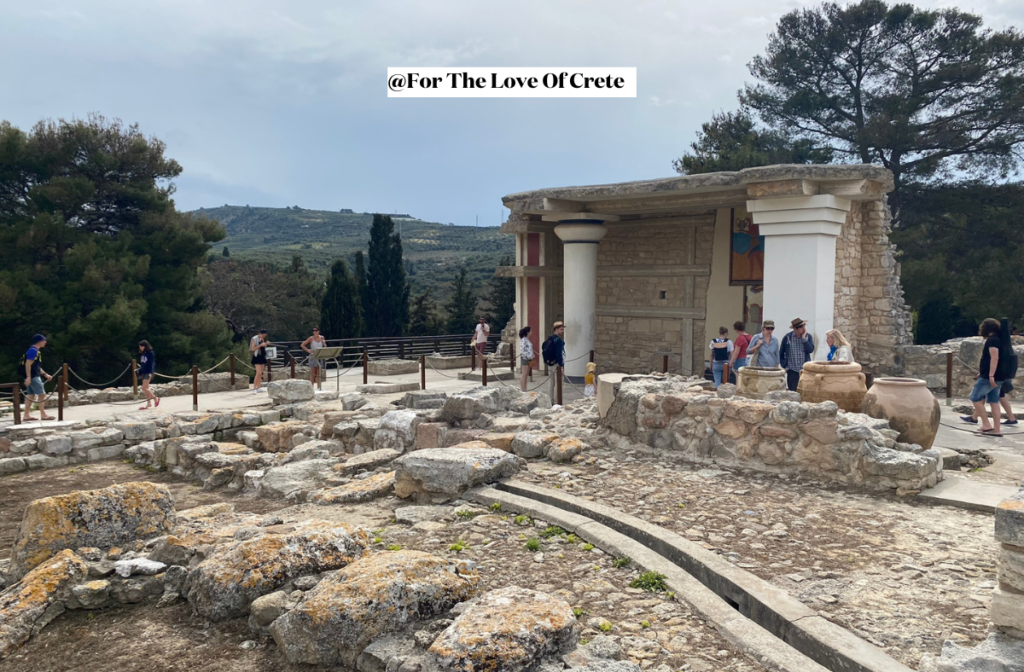
Making the Most of Your Visit
Plan for 2-3 hours to properly explore the site. The archaeological complex is extensive, and you’ll want time to appreciate the architectural details and innovative engineering features.
Best times to visit:
- Early morning (8:00-10:00 AM) or late afternoon (after 4:00 PM) to avoid peak crowds
- Spring and fall for milder temperatures
- Weekdays tend to be less crowded than weekends
Having spent many hours exploring these ancient stones, I can tell you that timing your visit right makes all the difference. I’ve found that early mornings here are magical – not just for avoiding crowds, but for watching the first sunlight illuminate the ancient stones.

Essential items to bring:
- Water bottles – no cafes inside the archaeological site
- Sun protection – much of the site is exposed
- Comfortable, sturdy shoes – the terrain is uneven
- Camera – photography is permitted throughout the site
Consider hiring a licensed guide or using the official audio guide to better understand the site’s historical significance. The complex layout and rich history become much more meaningful with proper interpretation.
For a deeper understanding of Minoan culture, pair your visit with the Heraklion Archaeological Museum, where you’ll find the original frescoes and artifacts discovered at Knossos. The museum provides crucial context for understanding the site’s archaeological significance.
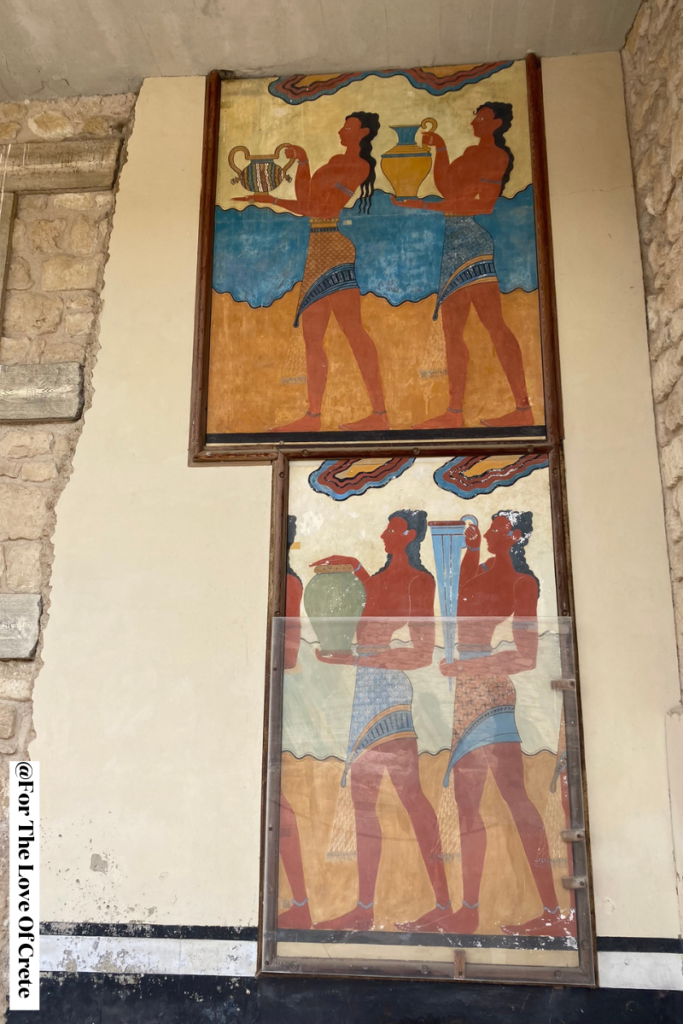
Ongoing Research and Discoveries
Knossos continues to yield new insights through ongoing archaeological research and site development. The palace complex has entered an exciting new phase of study and preservation, with several major initiatives underway.
Current Development Projects
Knossos continues to yield new insights through ongoing archaeological research and site development. The palace complex has entered an exciting new phase of study and preservation through the Knossos 2025 Project, a collaborative initiative between the British School at Athens (BSA) and the Hellenic Ministry of Culture and Sports.

Current Development Projects
The centerpiece of this development is the Stratigraphical Museum renovation, supported by a £2.6 million investment. This ambitious project will:
- Double the museum’s size with a new mezzanine floor
- Create over 700 square meters of modern study and storage space
- Establish new laboratories for ceramic analysis and bioarchaeological research
- Enable detailed analysis of newly discovered artifacts in controlled environments
- Preserve and protect more than a century of archaeological discoveries
- Provide digital access to collections for researchers worldwide
Conservation Efforts
It’s fascinating to watch how modern conservation techniques are helping preserve these ancient stones for future generations.
Current preservation work focuses on addressing critical challenges at the site, particularly the restoration of Sir Arthur Evans’s early 20th-century reconstructions. Key conservation priorities include:
- Repairing deteriorating reinforced concrete structures
- Treating rusted ironwork within reconstructed areas
- Protecting the site from damage caused by wet Cretan winters
- Managing the impact of increasing tourist foot traffic
The ongoing work at Knossos demonstrates the site’s continuing importance in our understanding of Minoan civilization. These conservation efforts aim to balance site preservation with public access, ensuring that future generations can continue to study and appreciate this remarkable archaeological treasure.

Beyond the Palace
Exploring ancient Crete extends far beyond the boundaries of Knossos Palace. The surrounding region offers several significant archaeological sites and museums that provide crucial context for understanding Minoan civilization.
Essential Related Sites
Trust me on this one – no visit to Knossos is complete without exploring the treasures housed in the Heraklion Archaeological Museum. This world-class museum houses the finest collection of Minoan artifacts, including the original frescoes from Knossos Palace, precious artifacts from various excavations, and the enigmatic Phaistos Disc. The museum’s detailed exhibits offer invaluable insights into Minoan daily life and culture.

Other Minoan Sites
Several significant Minoan sites near Knossos offer deeper insights into this ancient civilization. The Phaistos Palace, Crete’s second most important Minoan site, provides a less crowded alternative to Knossos. Its well-preserved architectural elements and spectacular mountain views offer visitors a unique perspective on Minoan architecture.
Ancient Gortys, Crete’s largest archaeological site, showcases the island’s Roman and Byzantine heritage alongside its Minoan past. The extensive ruins include impressive ancient structures and significant inscriptions that help document the region’s rich history.
Along the Geropotamos River, Agia Triada presents visitors with a remarkable Minoan villa complex. This site, with its evidence of an ancient marketplace and architectural developments, demonstrates the evolution of Minoan building techniques and social organization.

These sites collectively offer valuable perspectives on Minoan civilization beyond the confines of Knossos, helping to build a more complete picture of ancient Cretan life.
Conclusion
The Ancient Palace of Knossos stands as one of the world’s most significant Bronze Age sites, offering visitors a remarkable glimpse into Minoan civilization. Whether you’re a dedicated historian or a curious traveler, the sophisticated architecture, innovative engineering, and stunning artistic achievements tell a powerful story of human ingenuity. A visit to Knossos, especially when combined with the Heraklion Archaeological Museum, provides an unforgettable journey into our ancient past. The experience will stay with you long after you leave.
Further reading: The Ultimate Guide to Minoan Mythology: Stories and Facts
